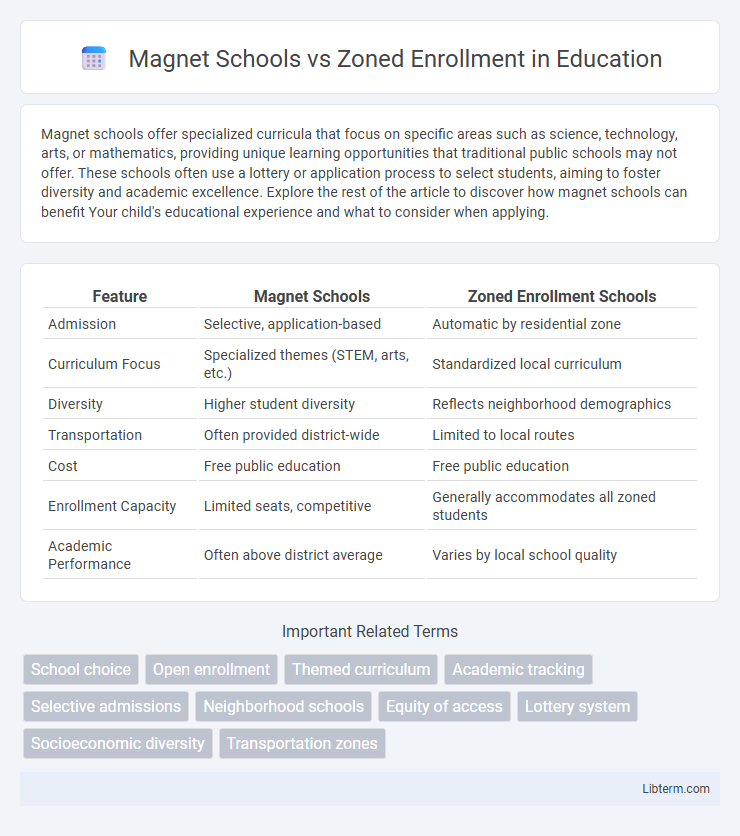Magnet schools offer specialized curricula that focus on specific areas such as science, technology, arts, or mathematics, providing unique learning opportunities that traditional public schools may not offer. These schools often use a lottery or application process to select students, aiming to foster diversity and academic excellence. Explore the rest of the article to discover how magnet schools can benefit Your child's educational experience and what to consider when applying.
Table of Comparison
| Feature | Magnet Schools | Zoned Enrollment Schools |
|---|---|---|
| Admission | Selective, application-based | Automatic by residential zone |
| Curriculum Focus | Specialized themes (STEM, arts, etc.) | Standardized local curriculum |
| Diversity | Higher student diversity | Reflects neighborhood demographics |
| Transportation | Often provided district-wide | Limited to local routes |
| Cost | Free public education | Free public education |
| Enrollment Capacity | Limited seats, competitive | Generally accommodates all zoned students |
| Academic Performance | Often above district average | Varies by local school quality |
Introduction to Magnet Schools and Zoned Enrollment
Magnet schools are public institutions designed to attract students from various districts by offering specialized curricula such as science, arts, or technology, promoting diversity and academic excellence. Zoned enrollment assigns students to schools based on their residential address within specific geographic boundaries, ensuring local access and community cohesion. Understanding the distinctions between magnet schools and zoned enrollment helps families make informed decisions about educational opportunities tailored to student needs and preferences.
Key Differences Between Magnet and Zoned Schools
Magnet schools offer specialized curricula and attract students based on interests or academic focus, whereas zoned schools serve students within specific geographic boundaries regardless of academic specialization. Magnet schools often provide unique programs in areas like STEM, arts, or language immersion, promoting diversity through selective enrollment processes, while zoned schools emphasize neighborhood-based attendance to maintain community cohesion. Enrollment in magnet schools typically requires applications and may involve lotteries, contrasting with automatic placement in zoned schools based solely on residential address.
Admission Processes: Magnet Schools vs Zoned Enrollment
Magnet schools select students through competitive admission processes that often include applications, lotteries, or specific criteria such as academic performance and talents, promoting specialized education themes. Zoned enrollment assigns students based on geographic boundaries, guaranteeing access to neighborhood schools without application requirements. This difference in admission structures impacts diversity, student choice, and resource allocation within public education systems.
Academic Curriculum and Program Offerings
Magnet schools offer specialized academic curricula designed to attract students with specific interests in areas such as STEM, performing arts, or language immersion, providing advanced programs and unique learning opportunities not typically available in traditional schools. Zoned enrollment schools follow standard district curricula aligned with state education requirements, emphasizing a broad and consistent academic foundation for all students within a geographic boundary. The distinct program offerings in magnet schools often include enhanced coursework, specialized instructors, and access to cutting-edge resources that support students' academic growth in targeted disciplines.
Student Diversity and Demographics
Magnet schools attract a diverse student population by offering specialized programs that draw students across traditional zoning lines, enhancing racial, ethnic, and socioeconomic diversity compared to zoned enrollment schools, which primarily serve students based on residential location. Research shows magnet schools often have higher percentages of minority students and more balanced representation of various demographic groups, promoting inclusive learning environments. Zoned enrollment schools tend to reflect the demographic makeup of their neighborhoods, sometimes leading to less diverse student bodies due to residential segregation patterns.
Impact on Student Achievement and Outcomes
Magnet schools, with their specialized curricula and rigorous academic standards, often demonstrate higher student achievement and improved outcomes compared to zoned enrollment schools, which serve students based on geographic boundaries. Research indicates that students in magnet programs benefit from enhanced engagement, diverse learning opportunities, and access to advanced resources, driving higher test scores and graduation rates. In contrast, zoned schools may experience variability in performance due to socioeconomic factors and community demographics influencing resource allocation and student support.
Transportation and Accessibility Considerations
Magnet schools often provide specialized transportation options to accommodate students from diverse geographic areas, enhancing accessibility beyond traditional neighborhood boundaries. Zoned enrollment schools rely primarily on local school buses limited to specific residential zones, which may restrict accessibility for students living further away. Transportation logistics and availability significantly influence equitable access to educational opportunities in both magnet and zoned enrollment systems.
Parental Choice and Community Involvement
Magnet schools offer parents the freedom to select specialized programs tailored to their child's interests and talents, enhancing parental choice beyond traditional neighborhood schools, which assign students based on geographic zones. This choice fosters deeper parental engagement as families actively participate in their child's educational path, often leading to higher satisfaction and involvement in school activities. Conversely, zoned enrollment encourages community cohesion by grouping local children together, promoting neighborhood bonds and collective participation in school events.
Funding and Resource Allocation
Magnet schools often receive specialized funding through federal grants and dedicated state programs that support their unique curricula and resources, allowing for enhanced educational materials and technology integration compared to zoned schools. Zoned enrollment schools primarily rely on local property taxes, which can result in significant disparities in funding and resource allocation based on the wealth of the surrounding community. This funding structure frequently leads to magnet schools having access to more diverse resources and extracurricular opportunities, while zoned schools may face challenges in maintaining equitable educational environments.
Pros and Cons: Magnet Schools vs Zoned Enrollment
Magnet schools offer specialized curricula and attract diverse students based on interests, fostering academic excellence and innovation, but may create inequities due to selective admissions and longer travel times. Zoned enrollment ensures neighborhood-based access promoting community cohesion and equal opportunity, yet often reflects local socioeconomic disparities and limits students' educational choices. Evaluating the trade-offs involves weighing specialized educational benefits against equity and accessibility in public school systems.
Magnet Schools Infographic

 libterm.com
libterm.com